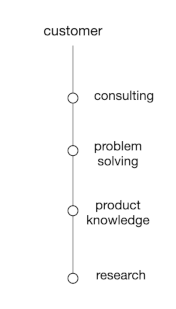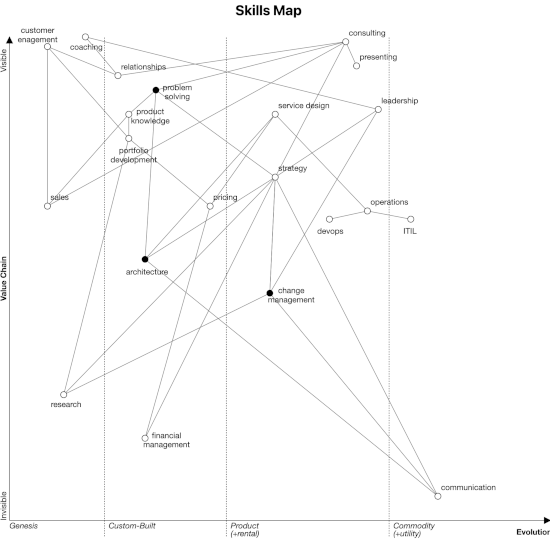
Over the past few months the tech industry has been going through the shock and awe of corporate downsizing that occurs when the economy feels like its about to enter a recession. Big Tech is making layoff after layoff, typically around 10% of the workforce and those are the ones we know about. Many tech companies (and others) will start following suit, even if not as publicly, as the market shrinks and spending slows with companies trying to save cash and preserve profits. Capitalism in many ways sucks!
With this grey cloud above us all, whether we have been made redundant or we’re safe for another day, everyone should be taking the time to look at their career. What are you looking for? What skills do you have? What skills do you want? Are you happy?
On a lazy afternoon with tea in hand and after reading yet another post about redundancies and I decided to grab a pen and paper and start a quick thought exercise - Could I use wardley mapping to map my skills?
Step 1 - Listing those skills
The first step is listing all those skills you have. Unless you regularly keep a brag document then, like me, you’re doing to find this a more difficult step that it first appears.
Some tips here:
-
What work are you actually doing regularly? Look back at your calendar for the past 3-months, what are you actually doing in your job? Coding? Writing? Speaking? Persuading? Mentoring?
-
What activities bring you joy and which do you hate? Our best skills are always the ones that we enjoy because it’s where we naturally focus our time and it’s where you want your career to be going. While giving you a list of skills, understanding what you enjoy and want to focus on will also be an important next step. Maybe there are also activities you hate, you might have the skills and people come to you for them but it’s not something you want to do any more?
-
What did you do in your previous jobs and what skills did you bring with you? Most skills deprecate over time but never completely leave us. Look back over your previous jobs and ask the same questions as the two above - what did you do, what did you enjoy?
-
Brain dump - don’t order Get it down on paper, scribble it down, be messy, don’t order it and take your time. When I was completing this first step I put it all down on a sheet of paper in my worse, quickest handwriting. I went for a walk, had a shower and came back to it the next day and wrote a few more down. If you’re not egotistical or skills mapping is not an existing habit for you this will require a bit of reflection and vulnerability. Reflection takes time.
Step 2 - finding the anchor(s) and building the dependencies
In wardley mapping the anchor for a map is typically the user, the position is the visibility to the user and the skills are the needs of that user.
So when mapping skills - who is your user? Who cares that you have these skills? It might someone at work (most likely - but who?), a friend or even a family member. Skills we have are not just those things that we sell to the highest bidder, but they are also the things that other people value us for, what our family and other people around us value.
It doesn’t matter too much as this stage what you choose as your anchor, but pick just one, as it will set the theme and narrative for your map.
Now with your anchor and your list of skills, start to build dependencies of those skills. Here is an example from my own map:
consulting -> problem solving -> product knowledge -> research
One thing I found really useful here is building mind maps (not real maps!). I took each skill on my list and built a small mind map for each one. Once I had a couple of pages of circles I started to notice the patterns and that helped me build the dependencies.
Step 3 - First map
With your dependencies in place, next step is to get them onto a map but for that you need to take your dependencies and make sure they are ordered according to the visibility of whatever user you’ve selected as your anchor. In the example I gave above they are already ordered - with consulting being the most visible and research the least. Now you have them in the right order for your Y-axis.
First time I put things on a map I always put them into the last column, the commodity zone:
“Liam you’re not special, everyone has your skills, put them in commodity” - Ouch! Past-Liam is harsh!

Well, guess what? The labels for the stages of evolution don’t really matter. In fact, I prefer using the different labels, more common when talking about practices: Novel, Emerging, Good and Best.
Well now that’s more useful. Is [this skill] my Best skill or is it new and Novel to me? Excellent, now we’re on a roll!
Add your next skill. Add 2 or 3 and then stop and reflect on what you’ve got.
Step 4 - Evolve
One of the key useful things about a map is that it communicates evolution - movement over time. This is really important when talking about skills because as we all know, skills we had 10 years ago that we’ve continued to invest in will likely we our Best skills and similarly if we’ve done nothing then those skills we once had, we might not have them any more (like when I played the flute as a kid).
It’s also important to look at evolution in the sense of where you want it to go. What skills do you want to invest in?
Being on a map also indicated what foundational skills you’ll need to develop first i.e. you don’t get to be good at consulting without being able to be a good communicator and a ok writer. You also don’t get to go into that area without experience of delivering those outcomes either.
Seeing how the skills depend on each other relative to your competency will provide you with a roadmap of areas to focus on. I’ll talk more about that next time.
Mistakes I made
Mapping is imperfect and always wrong. It’s not a science, it’s a tool for thinking and for communication. Using wardley mapping for mapping my own skills, I’ve made a bunch of mistakes that hopefully you can learn from as you complete yours:
-
I am not the anchor In my first scribbled drawings I didn’t really name my anchor, I just assumed it was me - they are my skills, right?! Well, yes. However your skills have a purpose and a value - and someone has need for that value. The person or persons with that need make a much better anchor. That doesn’t mean you can’t get the skills that you want but don’t know who needs it yet - but especially when focusing on your career development it’s better to focus on the needs of the person hiring for a particular job role you want.
-
Only choose one anchor As I started building out my map, I found that I was mentally grouping skills based on different roles I have had and different customers I had served over the years. I started adding some more anchors to my map as I thought of them. My advice is don’t do this because it complicates the map really quickly, not only because you find yourself adding the noise of all those additional relationships but also because it opens the door to adding more skills and therefore even more complexity. Remember a map has a narrative so one or two anchors are fine to tell that story. Use multiple maps with different stories if you want to have multiple anchors.
-
My map was too complex due to mixed-levels of granularity By starting with a complete list of all my skills, I found that I started with a lot of volume in terms of components on my map. That meant that I was working at both a micro and a macro context. For example: I have a skill in developing technical architectures, I also have skills in development and infrastructures as code. There are obvious relationships between those things but they also operate and different context levels. By mapping one or two “macro-level” skills and building those out you can really go deep into a particular area. Alternatively, you might be looking at your resume and want to focus more on the high-level skills. This is an area where calling out sub-maps can be useful. I’m just digging into this area in my own maps to finding the right-level of detail, so continue to iterate until you find the right level for the story you’re telling.
Next Steps
Well, like all mapping exercises, this is just the beginning of a journey and there are plenty of areas to look at and dig into.
Next up I’ll be looking at how to use a map once you’ve got it and what other questions it opens up. This includes things like evolution of skills, gameplay of your career to get the skills you want and how to visualise the alignment of skills to a job role.
Bonus here are my maps:

My Skills Map(s) on GitHub
Hopefully you found all of this useful and come back next time for see how I evolve my maps and how I’m using them in the real world.